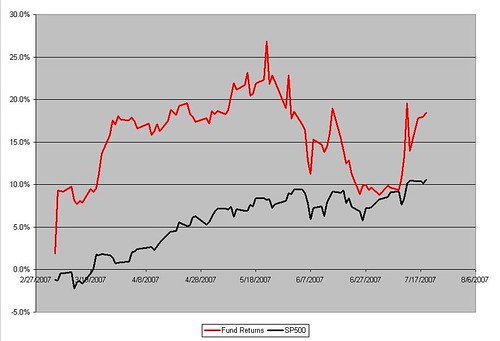"All life demands struggle. Those who have everything given to them become lazy, selfish, and insensitive to the real values of life. The very striving and hard work that we so constantly try to avoid is the major building block in the person we are today."
-- Ralph Ransom
"Restlessness and discontent are the first necessities of progress."
-- Thomas Edison
"All progress is based upon a universal, innate desire on the part of every organism to live beyond its income."
-- Samuel Butler
"Humanity has advanced, when it has advanced, not because it has been sober, responsible, and cautious, but because it has been playful, rebellious, and immature."
-- Tom Robbins
"Progress is made by lazy men looking for easier ways to do things."
-- Robert Heinlein
"Thinkin of a master plan, Cuz ain't nuthin but sweat inside my hand"
-- Rakim
"Ain't only three things to gambling: knowing the 60-40 end of the proposition, money management, and knowing yourself. Even a donkey knows that."
-- "Puggy" Pearson
"Things may come to those who wait, but only the things left by those who hustle."
-- Abraham Lincoln
"Go confidently in the direction of your dreams."
-- Henry David Thoreau
"Nothing focuses the mind better than the constant sight of a competitor who wants to wipe you off the map."
-- Wayne Calloway
"We are not here merely to make a living. We are here to enrich the world, and we impoverish ourselves if we forget this errand."
-- Woodrow Wilson
"The Longer I live, the more I realize the impact of attitude on life. Attitude, to me, is more important than facts. It is more important than the past, than education, than money, than circumstances, than failures, than successes, than what other people think or say or do. It is more important than appearance, giftedness or skill. It will make or break a company, a church, a home, or a chorus. The remarkable thing is we have a choice everyday regarding the attitude we will embrace for that day. We cannot change our past, we cannot change the fact that people will act in a certain way. We cannot change the inevitable. The only thing we can do is play on the one string we have, and that is our attitude. I am conviced that life is 10% what happens to me and 90% how I react to it. And so it is with you, we are in charge of our attitudes."
-- Charles Swindol
"Empty pockets never held anyone back.
Only empty heads and empty hearts can do that."
-- Norman Vincent Peale
"Our deepest fear is not that we are inadequate. Our deepest fear is that we are powerful beyond measure. It is our light, not our darkness that most frightens us. We ask ourselves, Who am I to be brilliant, gorgeous, talented, fabulous? Actually, who are you not to be? You are a child of God. Your playing small does not serve the world. There is nothing enlightened about shrinking so that other people won't feel insecure around you. We are all meant to shine, as children do. We were born to make manifest the glory of God that is within us. It is not just in some of us; it is in everyone. And as we let our own light shine,we unconsciously give other people permission to do the same. As we are liberated from our own fear, our presence automatically liberates others."
-- Marianne Williamson
"I've never been poor, only broke. Being poor is a frame of mind.
Being broke is only a temporary situation."
-- Mike Todd
"Wait for a miracle and it will never come. Take responsibility and you'll invite a miracle."
-- Laura Berman Fortgang
"The mind once stretched by a new idea, never returns to its original dimension."
-- Oliver Wendell Holmes
"Making mistakes simply means you are learning faster."
--Weston H. Agor
"If you really want to do something, you'll find a way; if you don't, you'll find an excuse."
-- Unknown
"A gem cannot be polished without friction, nor a person perfected without trials."
-- Chinese proverb
"Ignorance is the night of the mind, but a night without moon and star."
-- Confuscious
"Better a diamond with a flaw than a pebble without."
-- Confucius
"You can't lose what you don't put in the middle...But you can't win much either."
-- Mike McDermott (Rounders)
"Circumstance does not make the man, it reveals him to himself. Men do not attract that which they want, but that which they are. Man is manacled only by himself."
-- James Allen
"The stock market is filled with individuals who know the price of everything, but the value of nothing."
-- Philip Fisher
"Conversation enriches the understanding, but solitude is the school of genius."
-- Edward Gibbon
"It is your work in life that is the ultimate seduction."
-- Pablo Picasso
"In my whole life, I have known no wise people (over a broad subject matter area) who didn't read all the time - none, zero."
-- Charlie Munger
"It had long since come to my attention that people of accomplishment rarely sat back and let things happen to them. They went out and happened to things."
--Elinor Smith
"High aims form high characters, and great objects bring out great minds."
--Tryon Edwards
"True happiness is not made in getting something. True happiness is becoming something. This can be done by being committed to lofty goals. We cannot become something without commitment."
--Marvin J. Ashton
"There is a close connection between getting up in the world and getting up in the morning."
--Anonymous
"The man who is born with a talent which he is meant to use finds his greatest happiness in using it."
--Johann von Goethe
"An individual who doesn't consciously select his goals is not really in control of his life. He is controlled. Without really knowing it, he is controlled by goals imposed by outside pressures (the expectation of other), or by habits (procrastination), or by desires (the longing to be honored and admired) and so on."
-- Anonymous
"Beaten paths are for beaten men."
--Eric Johnston
"The world turns aside to let any man pass who knows whither he is going."
--David Starr Jordan
"First, the only certainty is that there is no certainty. Second, every decision as a consequence is a matter of weighing probabilities. Third, despite uncertainty we must decide and we must act. And lastly we need to judge decisions not only on the results, but how those decisions were made."
-- Robert Rubin
"We cannot promise to beat the market or even to match the market. But we can promise that nobody will care more about your money and work harder than the team that we have assembled."
-- Bill Miller
"When we think about the future of the world, we always have in mind its being where it would be if it continued to move as we see it moving now. We do not realize that it moves not in a straight line… and that its direction changes constantly."
-- Ludwig Wittgenstein
"The thoughts of others
Were light and fleeting,
Of lovers' meeting
Or luck or fame.
Mine were of trouble,
And mine were steady,
So I was ready
When trouble came."
-- A.E. Housman
"Entrepreneurship is not a civilized joust. It is streetfighting."
-- James Hong
"Pray not for lighter burdens but for stronger backs."
--Theodore Roosevelt.













































